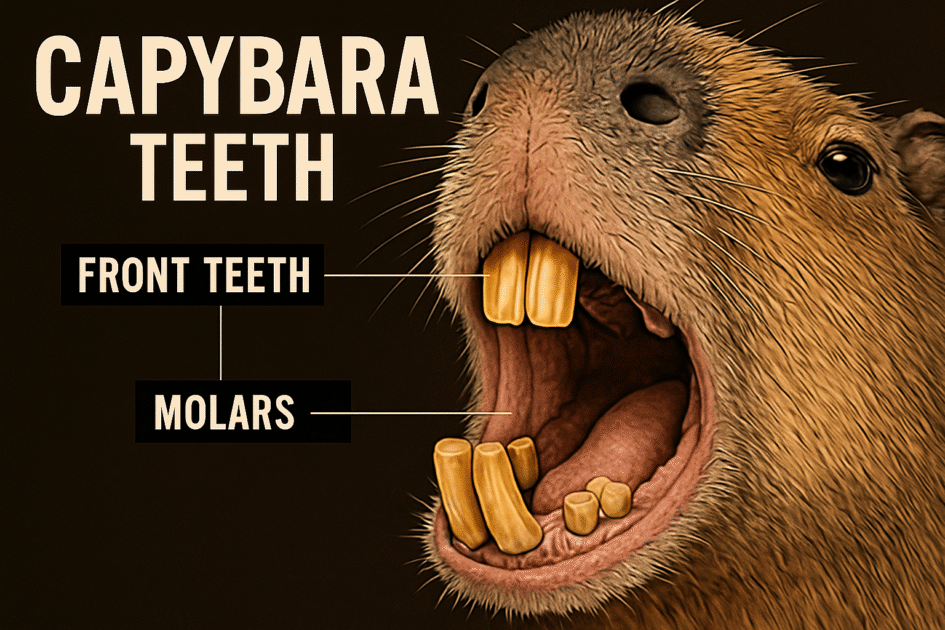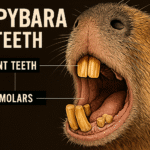
Capybara Teeth: Structure, Adaptations, Evolution, and Essential Dental Pet Care
July 9, 2025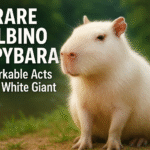
Rare Albino Capybaras (Remarkable acts you should know about the white giant)
July 11, 2025Capybara Teeth: Structure, Adaptations, Evolution, and Essential Dental Pet CareHow Fast Can a Capybara Run? (Speed, Survival, and Surprising Comparisons)
Capybara has 20 teeth comprising 4 sharp incisors, 4 rigid premolars, and 12 strong molars. These teeth are continuously growing, just like other rodents. In order to maintain their ever-growing teeth, capybaras have adaptations to prevent choking and injury from their sharp teeth.

What are the types and structures of teeth?
Dental Formula: 1/1 incisors, 0/0 canines, 1/1 premolars, 3/3 molars (for each side, upper/lower)
1. Incisors
A capybara has one pair of incisors on each jaw. Incisors are large, curved, chisel-like front teeth designed for cutting vegetation.
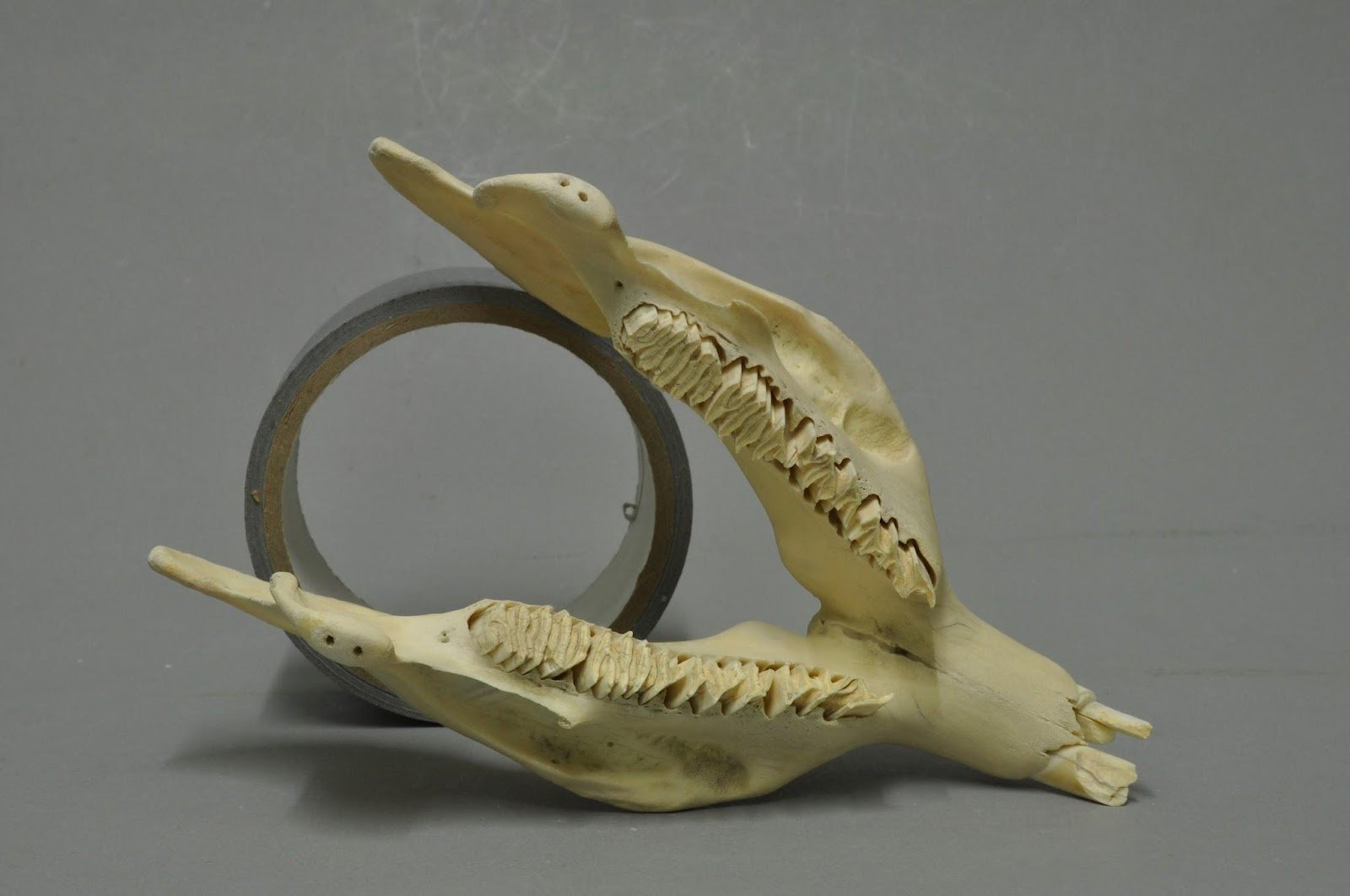
2. Molars and Premolars/Cheek Teeth
Capybara has one pair of premolar and 3 pairs of molars on each jaw. Together, they are called Cheek Teeth. Capybara’s molars and premolars are broad and rigid and move horizontally to grind the tough vegetation.
How Sharp Are Capybara Teeth, and How Do They Stay That Way?
Capybara teeth are very sharp as they are required to feed on barks and strong vegetation.
Incisors of rodents are supposed to be sharpened, as they are used to tearing pieces from the large and rigid barks and vegetation.
Incisors have a strong enamel coating on the front side and soft dentin on the inside. When they gnaw and chew on hard things, the soft dentin wears more fast and easily, making incisors more sharp.
Do Capybara Teeth Grow Forever? What’s the Root Structure Like?
Do you remember when you were young and lost your baby teeth? After a while, your adult teeth grew in to replace them. But if you lose an adult tooth, it won’t grow back—once they’re gone, they’re gone for good. Because we have closed roots (or fully developed roots), we can not grow more teeth.

But capybara has open roots for both their incisors and cheek teeth, allowing them to grow continuously. Deeply embedded incisor roots create chisel-shaped teeth.
What Are Postnatal Dental Characteristics in Capybaras? (Teeth of Baby Capybara)
Capybara babies are precocial, meaning they are born well-developed and can function independently soon after birth. They are born with their eyes open, teeth, fur, and strong limbs to move around after hours of birth.
They have postnatal teeth that allow them to graze immediately after birth. These postnatal characteristics allow them to survive on their own, even at a very young age.
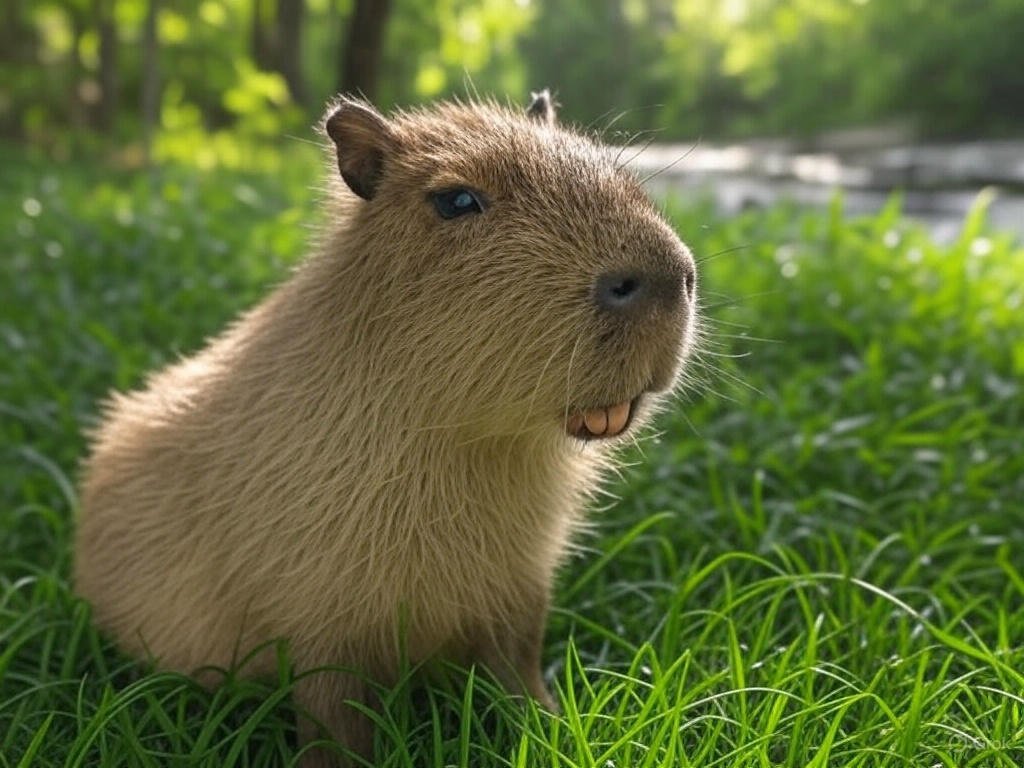
What is the Natural Remedy for Dental Care?
Capybara diet (feeding on strong vegetation) and behavior (gnawing and chewing) maintain proper tooth wear. In wild individuals, tooth growth and wear stay balanced. Captive capybaras develop malocclusion (Improper alignment) because of a lack of tough food.
What are Common Capybara Dental Problems?
Ever-growing teeth can have some abnormalities that can cause serious health problems to capybaras. This happens when capybaras don’t have access to the right material to chew on.
1. Overgrowth:
Teeth overgrowth is a common issue in captive capybaras. This overgrowth can lead to serious health issues, including difficulty eating, oral pain, and even injuries to the mouth or surrounding tissues.
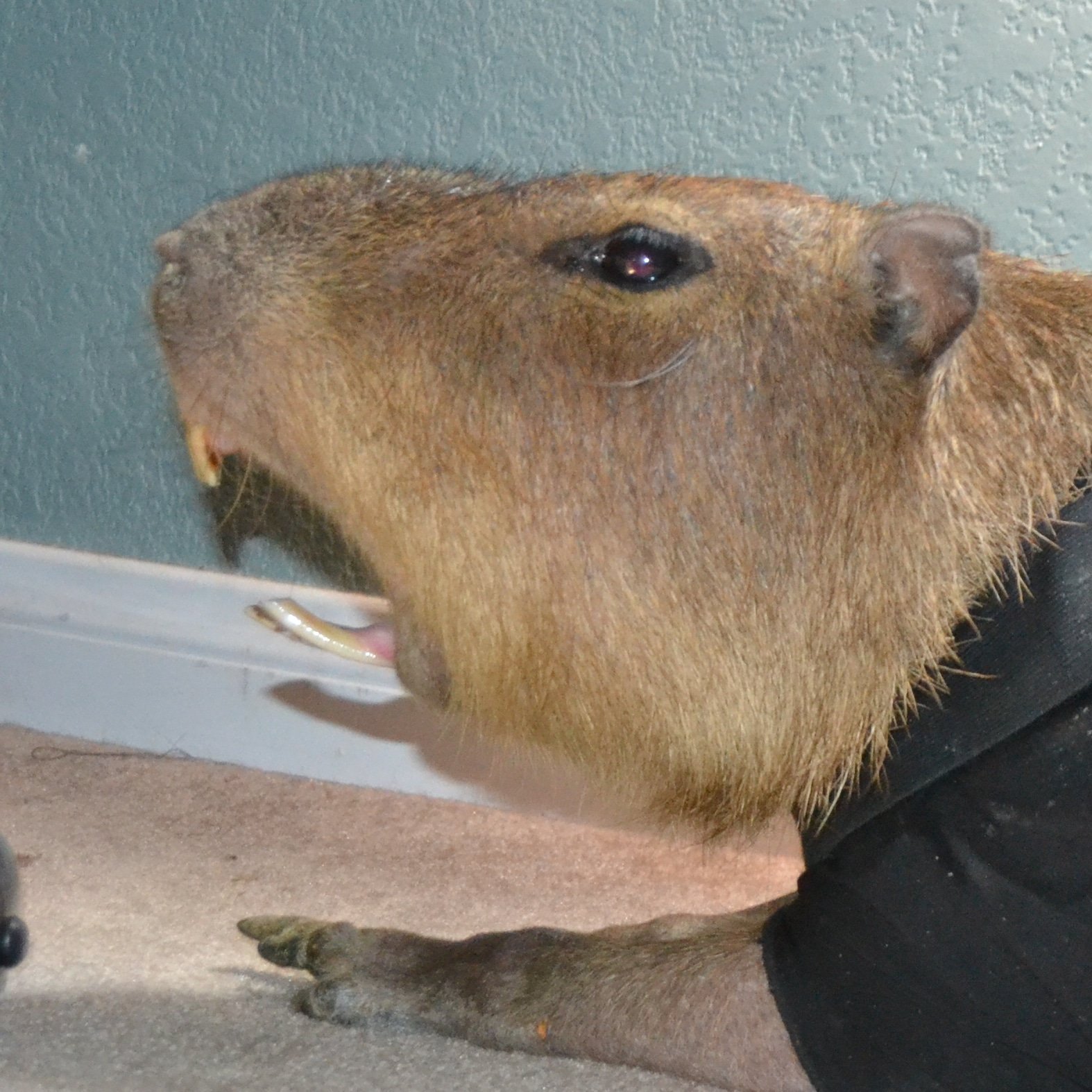
2. Asymmetrical Teeth:
Abnormal wear can cause malocclusion: teeth cannot align properly. Unalignment of teeth can cause oral pain, difficulty in eating, and drastically reduce the chances of survival in wild individuals.
In severe cases, the roots of the teeth might elongate or shift, causing jaw misalignment or even temporomandibular joint (TMJ) issues. This can make it painful for the capybara to open or close its mouth, further limiting its ability to eat. In the wild, capybaras with jaw pain might struggle to forage effectively, making them more vulnerable to predation or starvation.
3. Tooth Loss:
Loss of a complete tooth compensates for the overgrown or large tooth because of a lack of proper feeding. Tooth loss is a virtue in disguise as it prevents the overgrown teeth disorders and drastically lowers the chance of infection.
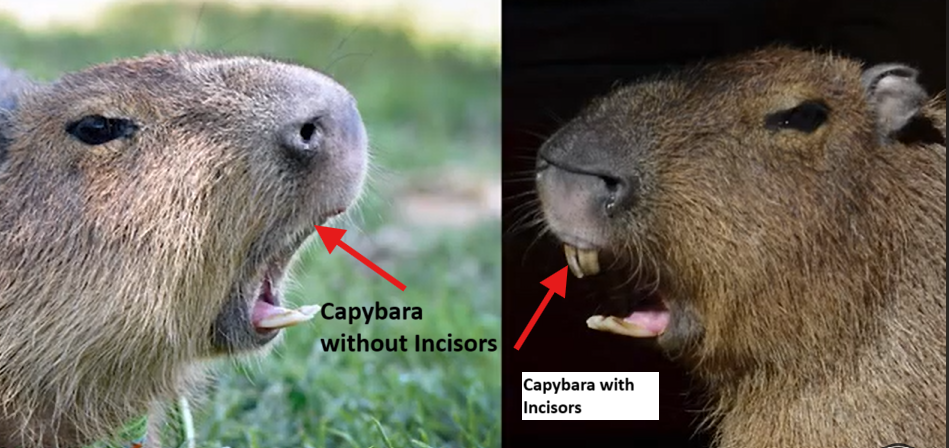
4. Infection/Abscesses:
Formation of wound and infection:
When the teeth grow too long, they can tear the gums, cheeks, or tongue, creating an open wound. These wounds are the perfect places for the nourishment of bacteria, causing an infection. Common bacteria involved in such infections include anaerobic species like Fusobacterium, Prevotella, or Porphyromonas, which thrive in the warm, moist conditions of the mouth.
Formation of Abscess:
The body’s natural response to the infection is filling the wounds with white blood cells, making pus pockets–an abscess. In capybaras, abscesses may form in the gums (gingival or periodontal abscess) or at the root of the tooth (periapical abscess) if the infection spreads deeper. The pus is a mix of dead tissue, bacteria, and immune cells, and it can cause swelling, pain, and pressure in the affected area.
Spread of infection:
Left untreated, the infection can extend beyond the mouth. For instance, a periapical abscess at the tooth root might erode into the jawbone, causing osteomyelitis (bone infection), or spread to nearby soft tissues, leading to facial swelling or cellulitis. In rare cases, it could even enter the bloodstream, though this is less documented in capybaras specifically.
5. Choking:
Choking isn’t a very common issue, but it can occur with a very rare chance only if teeth are grown in such a way that they physically block the air passageway. Overgrown cheek teeth can create uneven surfaces or sharp points, causing food to get stuck in the mouth rather than being pushed back for swallowing, increasing the risk of lodging in the throat.
How Do Capybara Teeth Function When They Eat?
Capybaras have mainly 2 types of teeth based on function:
1. Incisor teeth (Vertical Movement):
The 2 pairs of incisors work when the upper and lower jaw move vertically. These are used to make pieces of large strong vegetation so that they can be further chewed by cheek teeth inside the mouth.
2. Cheek Teeth (Horizontal Movement):
Now that the food is broken down into small pieces, it’s ready to chew into ingestible pieces. The cheek teeth move horizontally to break down the food into ground pieces. This helps them to engulf the food and maximize food absorption.
Why Do Capybaras Have Such Big Teeth?
The big teeth of the capybara are not just for eating, but they also help them with their defensive mechanism. Every living organism has some kind of defense mechanism, e.g., horses use their back legs to attack, while bacteria use chemicals in order to protect themselves.
Capybara uses their teeth for the following purposes other than eating:
1. Communication among the group:
Capybara always lives in a group of 10-20 individuals. They need different ways to communicate to survive as a group. They also communicate with each other by making different sounds using their teeth to tell other members about danger and food opportunities.
2. Showing stress or danger:
Capybara is not domesticated, but a habituated wild animal. They can feel danger or stress during encounters with humans and other animals. When they feel danger, they use their teeth to make noises that show their stress and feelings.
The frequency of the chattering is directly related to the amount of anxiety they felt. More chattering means they are feeling more danger. Making distance when you see them chattering their teeth.
3. Defense against predators:
Capybara can bite when they feel danger and threatened. Biting is the best defense mechanism Capybara can do other than run away.
Can Capybaras Bite? How strong is their bite?
Yes, capybara can and will bite if it feels threatened. Their bite is powerful and sharp due to their strong jaws and long, razor-edge incisors. Capybaras are peaceful animals, but here is a case study that shows an accident of a capybara bite.
Dental Comparison Between Different Animals:
| Animal | Total Teeth | Dental Formula | Continuous Growth? | Primary Diet | Key Dental Features |
| Capybara | 20 | 1/1 Incisors, 0/0 Canines, 1/1 Premolars, 3/3 Molars | Yes | Herbivorous (grasses, aquatic plants, bark) | Very large, ever-growing incisors with self-sharpening enamel; broad, ridged molars designed for grinding tough, fibrous vegetation. |
| Nutria | 20 | 1/1, 0/0, 1/1, 3/3 | Yes | Herbivorous (aquatic vegetation, roots) | Similar dental structure to capybaras, but with distinct orange-colored enamel; moderate incisor length adapted for processing soft aquatic plants. |
| Beaver | 20 | 1/1, 0/0, 1/1, 3/3 | Yes | Herbivorous (wood, aquatic plants) | Exceptionally strong, chisel-shaped incisors designed for gnawing wood; continuously growing incisors that require constant wear from heavy-duty chewing. |
| Rat | 16 | 1/1, 0/0, 0/0, 3/3 | Yes | Omnivorous (grains, seeds, fruits) | Smaller, rapidly growing incisors that are well-suited for gnawing on a variety of materials; fewer teeth overall compared to larger rodents. |
| Mouse | 16 | 1/1, 0/0, 0/0, 3/3 | Yes | Omnivorous (grains, seeds) | Tiny, continuously growing incisors with a high rate of wear and replacement; efficient for their size, but less robust than larger rodents. |
| Guinea Pig | 20 | 1/1, 0/0, 1/1, 3/3 | Yes | Herbivorous (grasses, hay) | Dental structure similar to capybaras but on a smaller scale; continuously growing incisors and well-developed molars for grinding fibrous plant matter. |
| Dog | 42 | 3/3 Incisors, 1/1 Canines, 4/4 Premolars, 2/3 Molars | No | Omnivorous (meat, dry food) | Non-continuously growing teeth; sharp canines for tearing and premolars/molars for crushing; dental structure optimized for a mixed diet. |
| Human | 32 | 2/2 Incisors, 1/1 Canines, 2/2 Premolars, 3/3 Molars | No | Omnivorous | A permanent set of teeth that require regular dental care; teeth are not self-renewing, making oral hygiene and preventive care essential. |
| Horse | 36–44 | 3/3 Incisors, 0–1/0–1 Canines, 3–4/3 Premolars, 3/3 Molars | Yes (Continuous Eruption) | Herbivorous (grasses, hay) | Hypsodont teeth with high crowns and continuous eruption to compensate for wear from grinding fibrous plant material; the presence of wolf teeth and canines varies. |
Capybara Drooling:
Drooling, also known as “Sialorrhea,” means the unintentional flow of saliva out of the mouth. In capybaras, there are two main reasons for drooling.
- Capybaras drool a lot when they eat food with fewer fibres. Capybaras simply over-chew it, which results in drool formation.
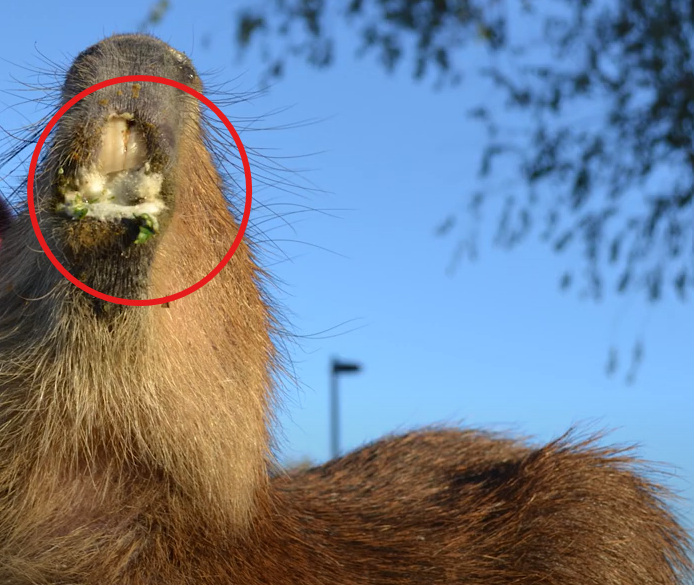
- Capybara does not have canines, leaving a free space called the diastema. When a capybara chews, some of the saliva escapes from these free spaces.
What is the Evolutionary History of Capybara Teeth?
Capybaras are the world’s largest rodents. They have developed their distinctive teeth from smaller caviomorph ancestors within the Caviidae family, such as guinea pigs and rock cavies. Capybaras have adapted to South America’s wetland environments over millions of years.
Capybaras have undergone several dental adaptations to nourish the wide range of vegetation in South America:
- Larger, Stronger Incisors: For cutting through tough plant stems and grasses.
- Complex, High-Crowned Cheek Teeth: For grinding fibrous and abrasive vegetation.
- Durable Enamel: Reinforced with iron to resist wear from silica-rich plants.
These changes allowed capybaras to grow into the large, semi-aquatic rodents we see today, as they have perfectly adapted to their ecological niche.
What are the most unusual objects chewed by Capybara?
Captive capybara can chew on strange household objects that are not meant to be a food source or hard enough to razor the teeth. The following objects are real-time examples of captive capybara:
1. Green Carpet:
Capybara can chew your beautiful carpet to get your attention. But that’s not their usual object to gnaw on.
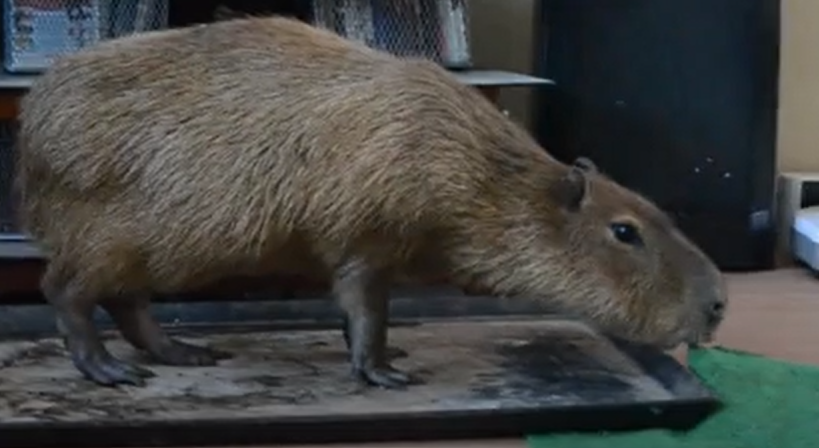
2. Sand:
Capybaras consume rocks and sand to naturally grind their teeth down. Eating sand can also help to fulfill the need for essential minerals present in sand. It is preferred to have chewable rocks for this purpose to prevent exposure to infections and worms.
3. Bone:
Capybaras are not very fond of bones. Initially, they may try to chew them, but will quickly lose interest.
Capybaras with broken teeth:
One of the most asked questions by Caybara’s owner is about the broken tooth. Tooth-broken things are very common in capybaras once or twice a year. They naturally break down their teeth at the baseline of gum.
New teeth grow very fast, even within days, and we can see significant growth. Their incisors can grow completely in a week or two, starting from the gum line.
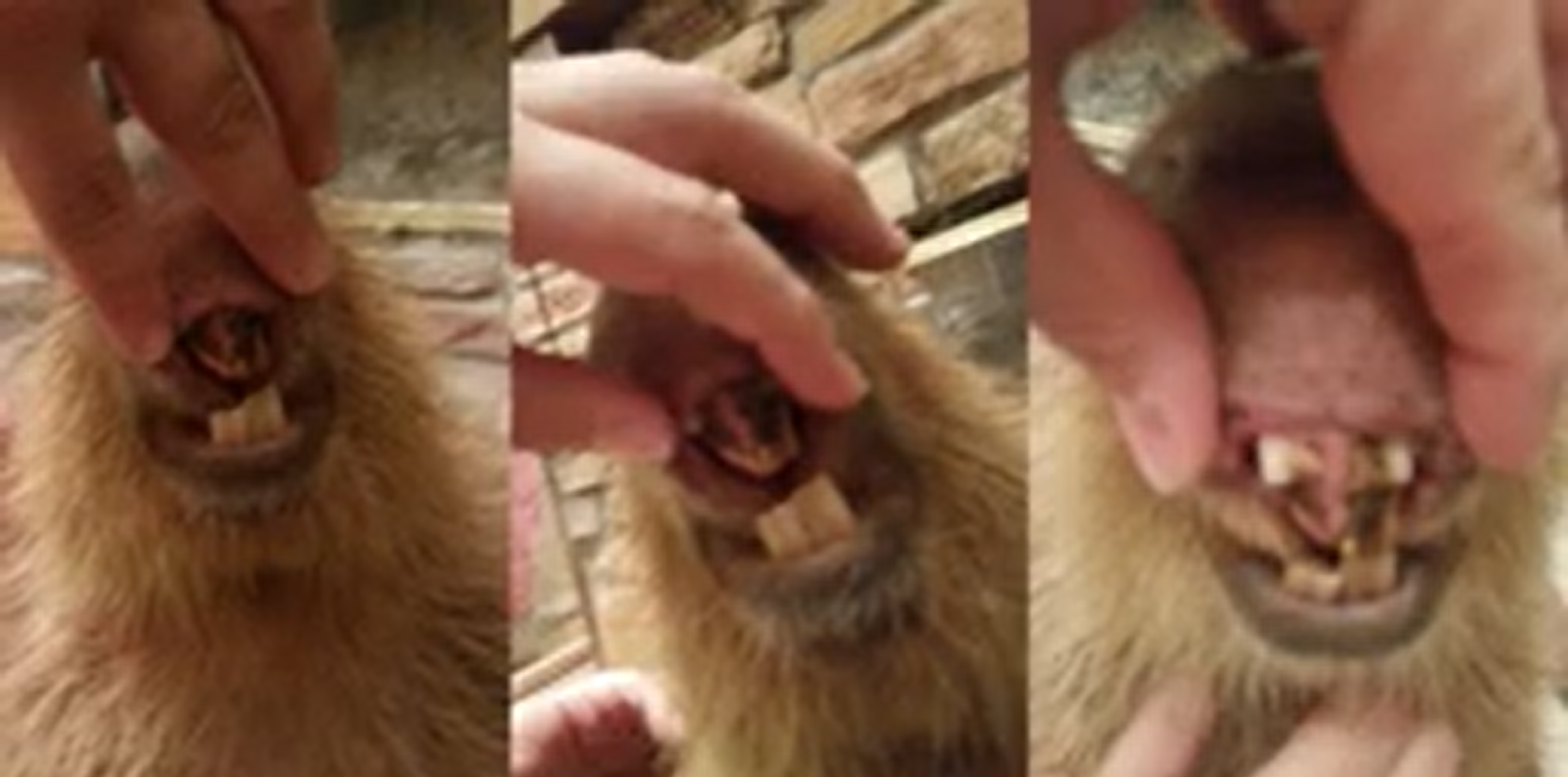
This is the side-by-side comparison of the Capybara incisors’ growth from day 1 to day 5.
Capybaras can lose more than one tooth at the same time.
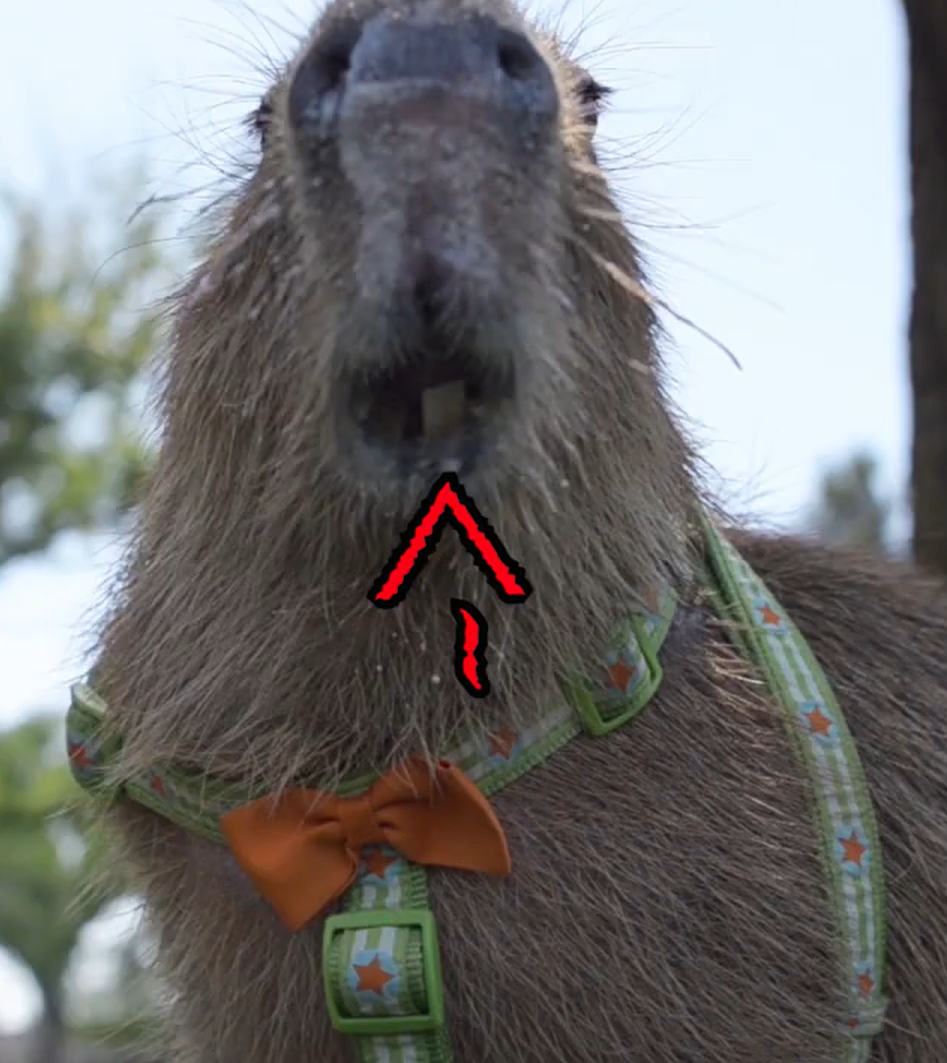
In this image, there is only one incisor present, and all the other incisors are deposited as gold reservoirs by the tooth fairy.
Special Behavior After Tooth Fall:
Some capybaras suck owners’ fingers right after their teeth are gone. First, I thought that maybe it was some kind of practice to enhance the relationship with Alpha (myself). But after some research, I came to know that sucking fingers increases saliva production that helps with sore gums and this also produces endorphins–the body’s natural painkillers.
Dental Tips for Pet Capybaras:
Captive Capybaras can be a potential victim of teeth overgrowth problems. Because they don’t have any access to hard materials to chew on like wild ones.
During petting a capybara, you have to make sure to give them proper hard objects like barks and rocks to avoid further complications.
All Things Considered:
Capybara teeth are the most important part of their body for nourishment and defense against predators. The sharp and long teeth are necessary to feed on hard vegetation, even bark. Capybara teeth have open roots, meaning their teeth are continuously growing like all other rodents. Capybaras have adapted well to their environment after millions of years of evolution.
Capybaras are wild animals, and there are some dental tips that we should keep in mind before making them pets. They must have access to hard objects like rocks to wear down their teeth. You should be in touch with a veterinarian to avoid any adverse situations.
“Capybaras always know how to ‘capy-tivate’ an audience with their charm!”

